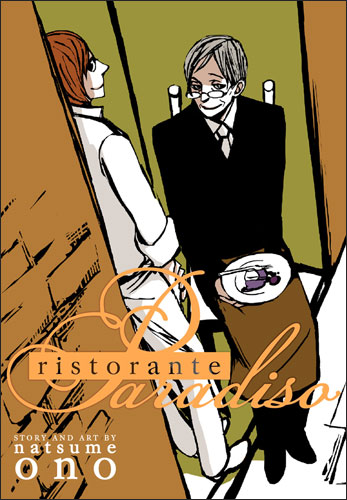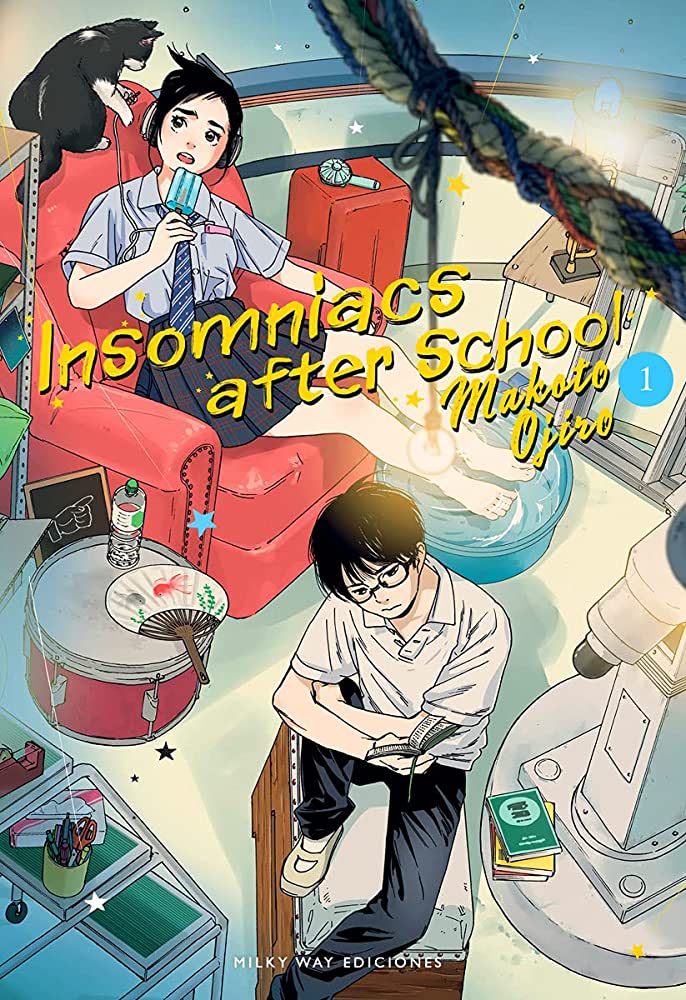Oh, Natsume Ono, I just can’t quit you! I was not wild about not simple, but try as I might, I couldn’t dismiss you as just another overrated indie artist. I couldn’t shake the memory of how I felt when I read the first few chapters of House of Five Leaves — that incredible sensation of discovering a new voice with something fresh to say, of having my love for manga validated all over again. So I picked up Ristorante Paradiso with high hopes. I’m happy to report I felt butterflies and excitement, just like the first time, and am firmly back on Team Ono.
Not that you didn’t test my patience — those first twenty pages were a slog, filled with the kind of amateurish moments that I might expect in a freshman effort. We learn that Casetta dell’Orso is popular because a character says it is; that the waiters are handsome because a character comments on how good-looking they are; that the loyal female clientele comes for the help not the food, again, because a character states it as a fact. In short, you have a bad case of telling instead of showing, of not trusting your artwork to demonstrate the restaurant’s popularity or the studliness of the wait staff. I nearly demanded the check.
Then something wonderful happened: the characters began to interact with each other, and in their impassioned conversations, we began to appreciate who they were, what drew them into the restaurant’s orbit, and why they seem stuck in certain unhappy, unfulfilling roles. Olga, the heroine’s mother, provides an instructive example. In the first few pages of the book, we witness a tense exchange between Olga and Nicoletta, the daughter she abandoned. Nicoletta, now twenty-one, has shown up on her mother’s doorstep demanding to be acknowledged, something Olga refuses to do out of fear that her current husband will leave her. It seems like you were stacking the deck against Olga, Ms. Ono, as Olga initially comes off as a dreadful Mommie Dearest who’s so committed to protecting her own interests that she initiates an elaborate charade to conceal Nicoletta’s identity. But then you slowly reveal how other people see Olga, as a vibrant, intelligent, giving woman who radiates warmth and charm. You help us understand that Olga is both a lousy, selfish mother and a loving wife to her second husband, two roles she struggles to reconcile. That we finish the book feeling sympathy for daughter and mother is testament to your storytelling skills and your obvious affection for your characters.
Your artwork, like your grasp of character, is stronger and more assured in Ristorante Paradiso than it was in not simple. As we watch the waiters moving through Casetta dell’Orso, for example, it’s easy to see why the female clientele swoons: the male characters have strong, distinctive faces that leave a lasting impression. They’re not conventionally handsome, but those faces have a wonderful, lived-in look that’s inviting and alluring — think of Alan Rickman, William Powell, or Marcello Mastroianni, not the smoothly perfect bishonen we’re so accustomed to seeing in manga. When Olga explains her attraction to Lorenzo, her husband, the artwork supports what she says: he’s drawn not as a fantasy object, but as a rugged, bearlike man whose virility is obvious even though his body and face are beginning to soften in middle age.
Put simply, Ms. Ono, you won my heart back. I found Ristorante Paradiso an engaging story filled with complicated, true-to-life characters who I enjoyed getting to know. It was a welcome departure from the emotional torture-porn of not simple, and a promise of good things to come: Gente and House of Five Leaves.




Khursten says:
Welcome back to Team Ono!! Ristorante and Gente are one of her better works (the best for me is still her BL line)and I wish all her works were like it.
I’m glad you liked it. She really does it best when she draws the personality of characters out. I realize that she’s not a grand story teller. She’s really better at the small stuff.
Katherine Dacey says:
Ristorante Paradiso reminded me a lot of Fumi Yoshinaga’s work, with lots of intimate scenes of characters talking. Ono’s dialogue isn’t quite as good as Yoshinaga’s — is anyone’s? — but I found Ristorante very engaging.
Glad to know I can leave the penalty box!
Jade says:
Oh, good, I was looking forward to this book, but I was a little worried. I mentioned before that what I enjoyed about not simple was probably more on my reading than in the book, so I was going to be a little more skeptical of this one.
I think one thing that bears mentioning is that those twenty pages may very well have been her transition from freshman to the artist she is today. According to her bio on Ikki, this was just her third story with only two years of publishing under her belt and not simple was only her second. I understand how fans of indie artists enjoy seeing early works, but Viz putting out not simple on the tail of a flagship like House of Five Leaves could really inspire the same sort of reactions that you had in the first part. Hopefully Ristorante is enough to split the difference.
Katherine Dacey says:
I think Ristorante will appeal to a lot of different readers: it has an Antique Bakery vibe that will appeal to Yoshinaga fans, but it also has that same bittersweet, intimate quality that House of Five Leaves does, so folks who liked not simple or Leaves will also like it. There are some passages that feel a little rough around the edges, but on the whole, Ono really seems to be hitting her stride here. Pretty amazing to think this was one of her first books!
Khursten says:
The dialogue? I’ve read the Japanese and I found it quite elegant and quite sexy, now that I think about it.
Although, again, I feel that something might have been lost in translation again. OTL. Oh dear, I hope Ono’s charm doesn’t die because of the translation.
At least, it was still, an enjoyable read.
Katherine Dacey says:
No need to panic: I thought the dialogue was fun, charming, and sexy, and the translation solid. I just think that Yoshinaga does dialogue better than just about anyone else. (Or else she has the best translator, take your pick!)
JRB says:
“We learn that Casetta dell’Orso is popular because a character says it is; that the waiters are handsome because a character comments on how good-looking they are; that the loyal female clientele comes for the help not the food, again, because a character states it as a fact.”
I’ve been on a how-to-make-manga-book jag, and I’ve noticed that Japanese manuals don’t seem to treat “show-don’t-tell” in the same way; I’ve come across several books now that actively recommend having a third party comment on the attractiveness of a character, or the impressiveness of a view, or the lovey-doveyness of a relationship, or what-have-you, as the most convincing way of conveying the feeling to the reader.
Actually, a lot of the advice given in Japanese books is diametrically opposed to what you would find in a Western writing course: use familiar plots; use simple, standardized character types, especially for secondary characters; copy the experts, do what the audience expects and likes, and don’t try to be too original. Now this is advice aimed at beginners, but still…
Katherine Dacey says:
That’s really fascinating, JRB! I guess that show-don’t-tell thing is so deeply ingrained in me that it makes me bonkers when an author has her characters say things that ought to be readily obvious from the art. Ono doesn’t do that throughout Ristorante Paradiso, just in the opening pages, so maybe she started to trust herself a little more. Or maybe she felt like she’d gotten the essential information out of the way and was free to start telling her story. Either way, the book gets a lot better as it goes along.
As for the manuals’ advice for beginners, I think it’s pretty sound. Most of us learn to write, draw, and compose through imitation (in fact, musicians spend the first three or four years of study copying examples by Bach, Schubert, Monteverdi, etc.), so it’s nice to see an instruction manual that acknowledges this important first step in developing your own voice. We sometimes place so much emphasis on individuality and originality of expression that we forget to teach the basics.
Thanks for that added perspective!
Ebod says:
You kind of HAVE to tell straight up that a character is handsome in a comic, considering the characters are drawn out and what may be visually appealing to the readers does not always equal good looking the fictional world the character dwells in (same vise versa – just because a character looks ugly to some readers does not automatically equal they are ugly in their fictional world).
It’s true that it’s often best to show instead of tell, but there are certain times when it is better to tell instead of show, and to demand that everything must be shown instead of told is ridiculous.
Katherine Dacey says:
Your point is well-taken, Ebod, but you’re blowing my comments out of proportion. I never said anywhere in my review that everything in a comic needs to be shown, not explicitly stated, just that some things should be readily obvious from the artwork. If I can’t figure out that a restaurant is popular without several characters telling me that in so many words, the artist needs to put more effort into showing me how busy it is. That’s all I’m trying to say.